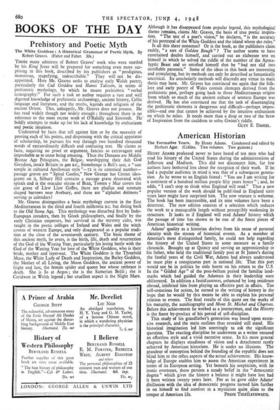BOOKS OF THE DAY
Prehistory and Poetic Myth
The White Goddess : A Historical Grammar of Poetic Myth. By Robert Graves. (Faber and Faber. 30s.)
THOSE many admirers of Robert Graves' work who were startled by his King Jesus will be prepared for something even more sur- prising in this book, described by his publishers as "prodigious, monstrous, stupefying, indescribable." They will not be dis- appointed. Here Mr. Graves seeks to analyse early Welsh poetry, particularly the Cad Goddeu and Hanes Taliesin, in terms of prehistoric mythology, by which he means prehistbric "verbal iconography." For such a task an author requires a vast and well digested knowledge of prehistoric archaeology, ancient history, Celtic language and literature, and the myths, legends and religions of the ancient Orient. This, unhappily, Mr. Graves does not possess. He has read widely though not widely enough • throughout there is no reference to the most recent work of O'Rahilly and Sjoestedt. He boldly attempts to make up for his lack of knowledge by enthusiasm and poetic intuition.
Undeterred by facts that tell against him or by the necessity of proving each of his points, and dispensing with the critical apparatus of scholarship, he pursues his way through two hundred thousand words of extraordinarily difficult and confusing text. He claims as facts, requiring no proof or argument, fancies so extravagant and improbable as to cease being amusing. Thus the Danaans are Middle Bronze Age Pelasgians, the Belgae, worshipping their Ash God Gwydion, inviie Britain in 400 B.C., Stonehenge is Beli's seat, a "sun temple in cultured Apollonian style "-72 is its canonical number— passage graves are "Spiral Castles," New Grange has Cretan ideo- grams on it, Silbury Hill contains a passage grave decorated with spirals and is the oracular shrine of Bran, Tomen y Mar covers the cist grave of Llew Llaw Gyffes, there are phallus and scrotum shaped barrows near Avebury, and there are "alphabet dolmens" serving as calendars!
Mr. Graves distinguishes a basic mythology current in the East Mediterranean in the third and fourth millennia B.C. but dating back to the Old Stone Age. This mythology was disturbed first by Indo- European invaders, then by Greek philosophers, and finally by the early Christian emperors, but survived in the mystery cults, was taught in the poetic colleges of Ireland and Wales and the witch covens of western Europe, and only disappeared as a popular tradi- tion at the close of the seventeenth century. The basic theme of this ancient myth, he avers, is the birth, life, death and resurrection of the God of the Waxing Year, particularly his losing battle with the God of the Waning Year for love of the White Goddess, who is their bride, mother and layer-out. The White Goddess is the Threefold Muse, the White Lady of Death and Inspiration, the Barley Goddess, the Mother of all Living, the Moon Goddess' the ancient power of fright and lust, the female spider and queen bee whose embrace is death. She is Jo at Argos ; she is the Sumerian Belili ; she is Ceridwen in Welsh legend ; her cruellest aspect is the Night Mare. Although it has disappeared from popular legend, this mythological theme remains, claims Mr. Graves, the basis of true poetic inspira- non. "The test of a poet's vision," he declares, "is the accuracy of his portrayal of the White Goddess and the island where she rules."
Is all this sheer nonsense? Or is the book, as the publishers claim rashly, "a sort of Golden Bough"? The author seems to have entertained doubts himself, and carried out an elaborate test on himself in which he solved the riddle of the number of the Apoca- lypgc Beast and so satisfied himself that he "had not slid into certifiable paranoia." Some of the ideas in this book are interesting and stimulating, but its methods can only be described as fantastically uncritical. Its unscholarly methods will discredit any virtue its main thesis may have. Mr. Graves has convinced me again that the folk- lore and early poetry of Wales contain elements derived from the prehistoric past, perhaps going back to those Mediterranean origins from which so much of the ancient culture of western Europe was
derived. He has also convinced me that the task of disentangling the prehistoric elements is dangerous and difficult—perhaps impos- sible—and one that cannot be achieved by the intuitive enthusiasm on which he relies. It needs more than a drop or two of the brew of Inspiration from the cauldron to solve Gwion's riddle.
GLYN E. DANIEL.


































 Previous page
Previous page